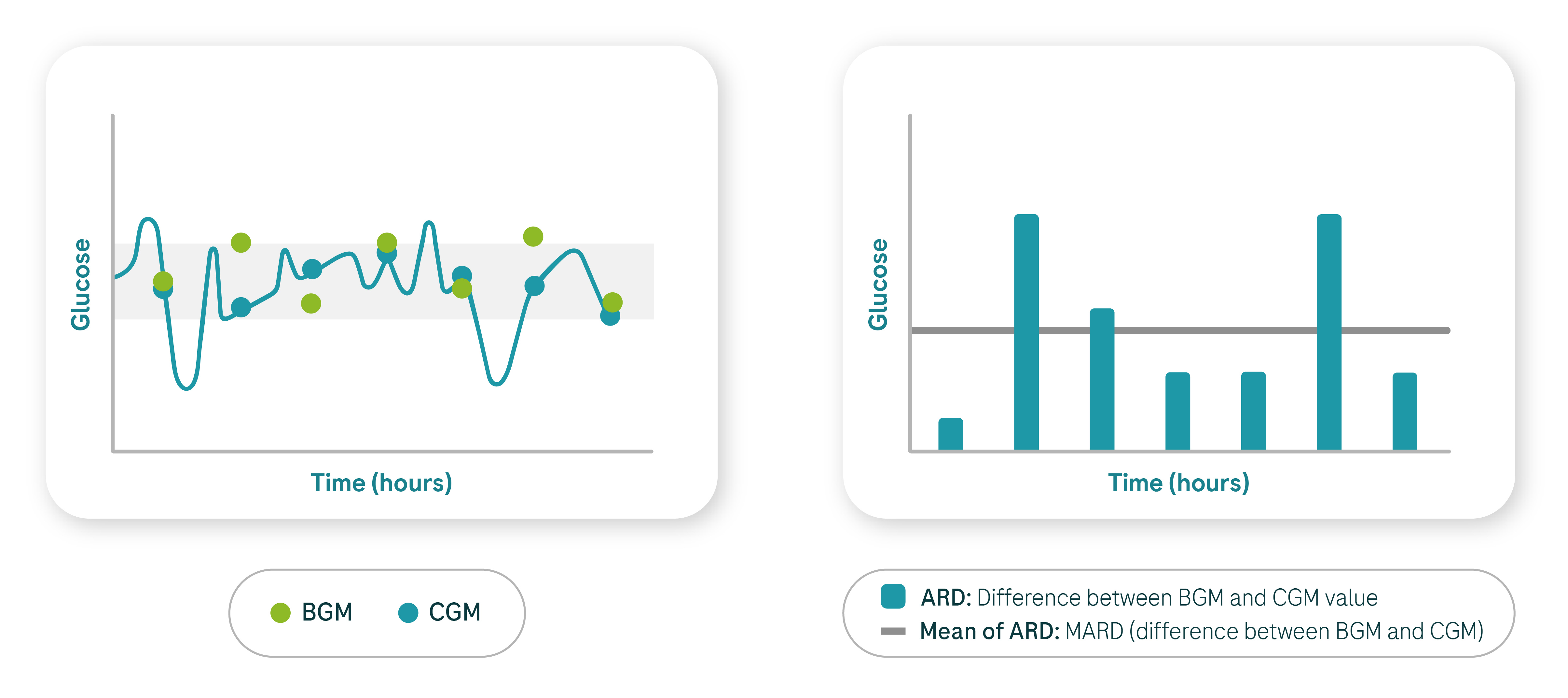MARD (mean absolute relative difference) is a measure of the accuracy of your CGM system.
If you're using or considering a Continuous Glucose Monitoring (CGM) system, you may have come across the term Mean Absolute Relative Difference (MARD). But what does it mean for you? Simply put, MARD is a way to measure how accurate your CGM is — the lower the percentage, the closer your sensor’s readings are to your actual blood glucose levels.1
How is MARD calculated?
Calculating MARD means checking how accurate your glucose sensor is. The accuracy is measured by comparing a series of blood glucose readings from your CGM monitoring device to a trusted reference method, typically a laboratory blood glucose test or finger-prick blood glucose test. The difference between the reference value and the CGM reading is calculated. Then, the difference between the CGM value and the reference is turned into a percentage. Taking the average of those percentages will give the Mean Absolute Relative Difference (MARD).

What affects MARD results?
While MARD is useful, several factors can impact MARD values2:
Blood sugar levels:
MARD can vary across different glucose ranges. Accuracy may be better in mid-range glucose values and slightly lower in very high or very low readings.
Because CGMs measure glucose in interstitial fluid rather than blood, readings may slightly lag behind actual blood glucose changes, especially after meals or during exercise
Sensor wear time:
Some sensors lose accuracy over time, with slight changes in MARD values toward the end of their wear period.
Calibration requirements:
CGMs may require manual calibration with a BGM, and rely on the accuracy of those reference readings, which can influence MARD.
Individual differences:
Certain medications and external factors (such as vitamin C, aspirin, and dehydration) may affect sensor readings, causing fluctuations in MARD results. Skin thickness, hydration levels, and sensor placement can all impact how accurately a CGM reads glucose.
What MARD means for CGM users
MARD helps you to understand how confident you can be with accuracy of your CGM readings. However, regardless of the MARD value,it’s important to:
- Always interpret your CGM data in context — consider trends, symptoms, and your daily routine.
- Be mindful of lag time and discuss timing when making treatment decisions with your healthcare provider.
- Confirm your values with finger prick tests when needed, especially if a reading conflicts with symptoms.
MARD is a helpful measure of CGM accuracy, but it’s not the only factor to consider. Understanding your CGM data is key to maximising its benefits. Consult your healthcare provider to find the most suitable glucose monitoring system for your diabetes care.
Next, learn more about Lag time.
1. Longo RR, Joshi R. The Devil Is in the Details: Use, Limitations, and Implementation of Continuous Glucose Monitoring in the Inpatient Setting. Diabetes Spectrum. 2022 Nov 1;35(4):405–19.
2. Kovatchev BP, Patek SD, Ortiz EA, Breton MD. Assessing sensor accuracy for non-adjunct use of continuous glucose monitoring. Diabetes Technol Ther. 2015 Mar;17(3):177-86. doi: 10.1089/dia.2014.0272. Epub 2014 Dec 1. PMID: 25436913; PMCID: PMC4346608.
Still having trouble? Contact us
*Some mobile phone operators may charge or restrict access for calls to these numbers. Calls to these numbers are subject to a local call charge, depending on your mobile network provider.
** This number is only for UK customers who are currently out of the country on a short term basis, please be aware that we cannot send replacement products abroad and advise that you take spare supplies with you. To improve the quality of our service, calls received or made by Roche Diagnostics Limited may be recorded.
Insulin Pump Consumable Orders
Phase out of
UK: 0800 701 000* or 020 3499 6159**
Ireland: 1 800 709 600* or 01 5410379**
Monday to Friday 8am-6pm excluding bank holidays.
UK: 0800 0211 241*
Ireland: 1 800 121 416*
Monday to Friday 8am-6pm excluding bank holidays.
UK: 0800 731 2291* (option 2)
Ireland: 1 800 882 351* (option 2)
You can reach us 24/7, 365 days
If you're a UK customer outside the UK, please call 0044 (0)1444 256019 (option 2)**